More on Core Words…
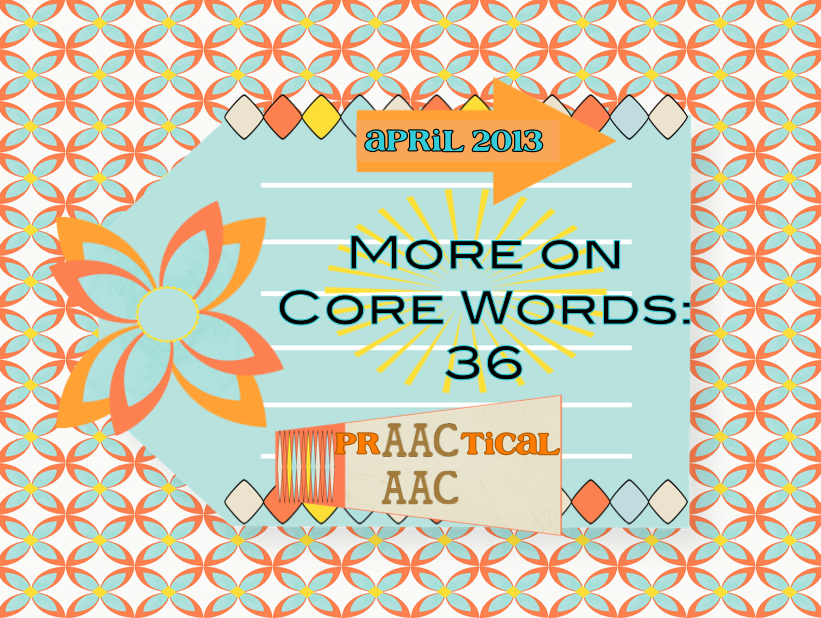
This month we have talked about core words and teaching strategies & considerations for facilitating USING core language. We have talked about aided language input, creating frequent opportunities, making connections b/w symbols and their referents, and motor planning/automaticity. As April ‘goes out’, we add graduated prompting/prompt hierarchies, and wait & signal/time delay prompts.
The key to teaching AAC core word language is strategies….
Aided language input (ALI) is fairly simple to do but sometimes overlooked. However, once it becomes habit, it is hard not to do even when you are ‘just’ talking about AAC displays. There are many clinical rationales or reasons why ALI is so important. It provides a model of the language we expect from the child (or adult), and how would anyone speak a language if they never ‘heard’ it. ALI also helps by introducing new words and symbols in meaningful contexts. If we are speaking AAC throughout the day then the student has models in authentic or real activities. ALI can be taught and used by significant others, so modeling is happening throughout school, home, and language intervention contexts. ALI also forces us to slow down when we are talking which allows the learner more time to process language. Another reason ALI is beneficial is that it helps us become familiar with vocabulary location on the AAC display. This is important as we use prompting to help the learner become successful with communication.
Creating frequent and specific opportunities for the learner to USE AAC is essential to becoming a competent AAC user. Just like most people learn more from DOING rather than listening or watching, so do AAC learners. Creating fun and meaningful ‘temptations’ for communication with core words allows the learner to practice being an effective communicator. The more prAACtice the better, but remember the prAACtice is in the activities you are already doing in school, at home, and in language intervention so it is not really extra work.
Making connections between symbols and the referent helps AAC learners understand and find symbols they will be using to communicate. Adapted games and activities designed to have the AAC learner identify new core vocabulary can help make it easier to locate the same vocabulary on an AAC display.
Motor planning and automaticity for locating words on an AAC display is also a consideration. In teaching any new skill or efficiency in activities, the process is typically kept consistent. Carole’s example of our computer keyboards is an excellent one, because it would be terrible for efficiency and learning if the keys were rearranged as we began to type. This example demonstrates the importance of trying to keep vocabulary in the same location on AAC displays, not only for the current version or system but even as you add vocabulary or change displays. One mistake that is often observed when teaching new vocabulary is that the facilitator rearranges the vocabulary so that the learner can ‘prove’ they know the new words. However, this is not teaching and not even a fair test, because when you learn to apply skills (in this case communication) and you have really learned it, you expect to find things where you last USED them.
Prompting or graduated prompting hierarchies are also part of the teaching strategy tool kit. When we learn a new skill, we can often be successful with a ‘little help’. This ‘little help’ though needs to be systematically planned for independence because the goal of prompts is to fade them as soon as they are not needed. Graduated prompting hierarchies lets us provide only the level of ‘help’ the learner needs (not too much or too little) during each communication opportunity. When students are first learning a skill, we often use a most to least prompting hierarchy. This has us going from the highest level of prompting necessary for learner and decreasing the level of prompting to none as quickly as possible. Once the learner has a level of skill established, the prompting hierarchy is switched to a least to most format which allows the learner student to attempt the task before assistance is provided while at the same time only giving the amount of information necessary for learner success for each communication opportunity. Some AAC prompting hierarchies samples and video demonstrations can be found from the Bridge School. YAACk, & Adaption Station also offer their prompting hierarchies.
A type of prompt that is also considered a language facilitation strategy is a wait & signal or time delay prompt. We have learned that by waiting expectantly for communication following the presentation of a communication opportunity, can be all that is needed to bring about a mostly independent communication initiation. For many ways to prAACtice waiting, check out: Little Stories 10 Ways to Practice Waiting.
In last week’s post, we selected 24 core words that might be a good starting point for learners. Today, we’re adding 12 more for a total of 36 and will go over some options for expanded language learning (just a few). Our 36 core vocabulary words are just examples but there are many more samples to review. It has been a somewhat crazy couple of weeks for us, but next week, we will share the communication boards that go with our 12, 24, & 36 core Strategy of the Month vocabulary posts.
HAVE FUN, ENJOY THE LANGUAGE, & LOVE THE INTERACTION!
36 Core Words: I, you, it, go, help, play, stop, want, all, big, different, fun, good, sad, more, not, on, away, here, tell, that, this, he, she, they, need, again, mine, question, place, time, know, in, what, where, who
Use ALI, Prompting, & Waiting to teach USE of 36 Vocabulary Core Words in Phrases in a Meaningful Language Experience (Accessible Playground Activity).
- ‘want stop play’ on the slide or jungle gym (pause… right before you go up the slide and turn away and choose something different).
- ‘not this again’ when headed to see saw
- ‘mine, you go play that’ with the sand toy that you brought to play ground (nicely take one of the sand toys and point to another one that the child likes)
- ‘tell where you want go play’ before you decide which activity to do next on the playground (when you are finished on each piece of equipment or with your own toys, stop, pause, and model)
- ‘this is not fun’ if child does not appear to like something
- ‘who is that playing’ when you see an unfamiliar person at the playground
- ‘she wants different place’ to leave the playground or if someone else is leaving (so can be request or comment)
- ‘I know he is sad’ if anyone else of child cries or screams on playground
- ‘help me again in this place’ if child has difficulty with a piece of playground equipment.
- ‘this is fun, love all here’ at the end of your playground time (if it appears true)
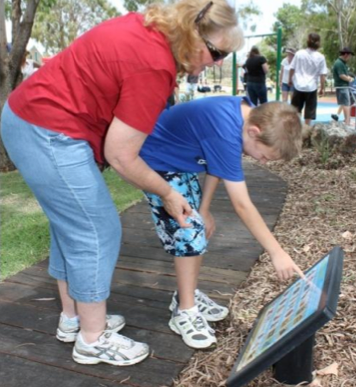
Filed under: Strategy of the Month
Tagged With: core vocabulary, meaningful language experiences
This post was written by Robin Parker
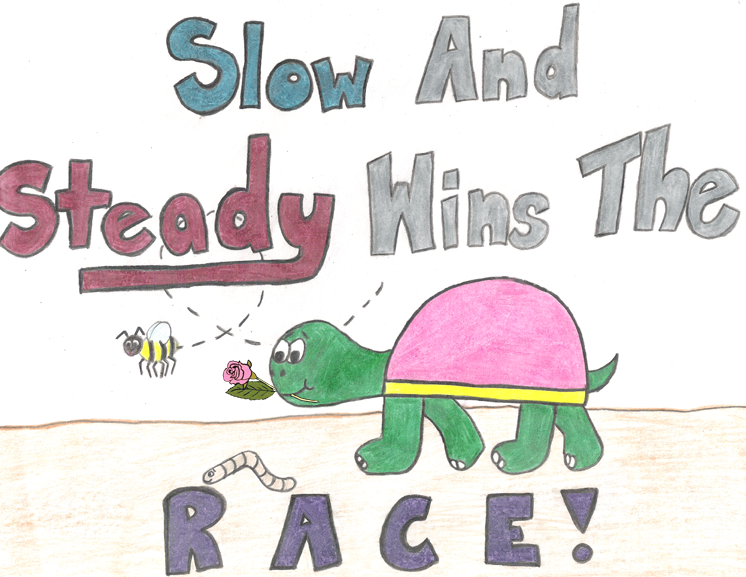

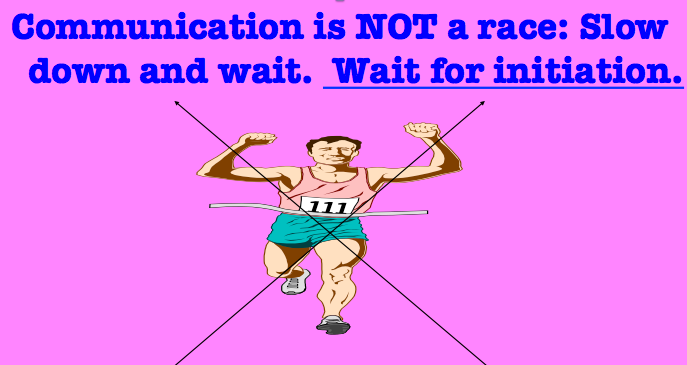
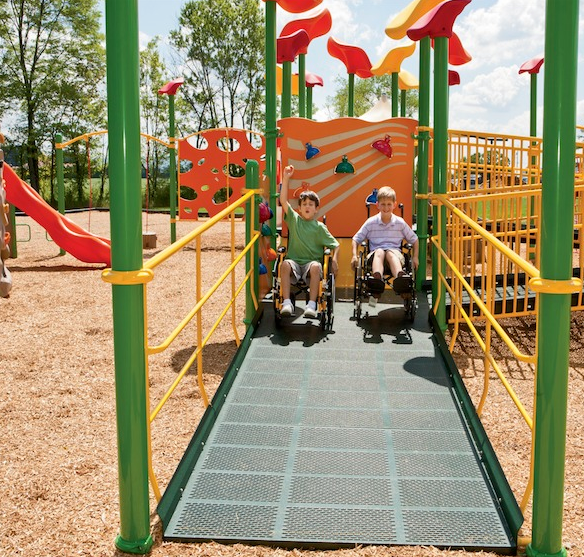

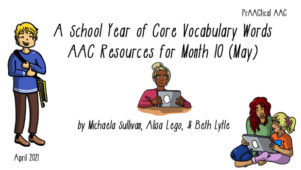
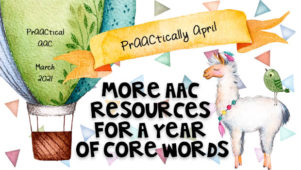
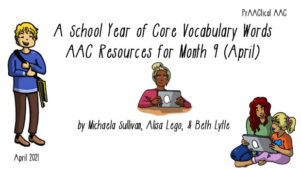
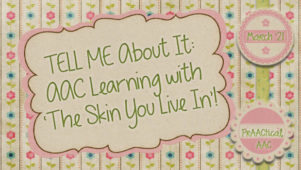
3 Comments
Great post – thank-you Robin! I will be referring to this in a presentation at AGOSCI this week – absolutely perfect 🙂
Thanks Jane so much!! We really appreciate you sharing your presentations so we can continue to learn from your amazing work.
I love the stand that the core board is in, where can I find one of those??